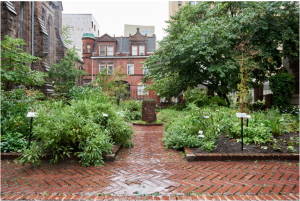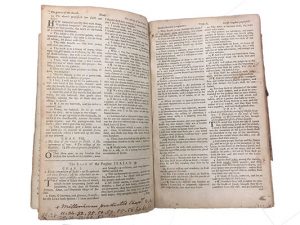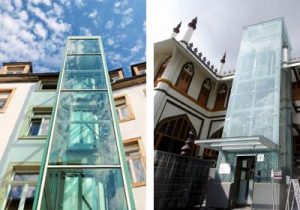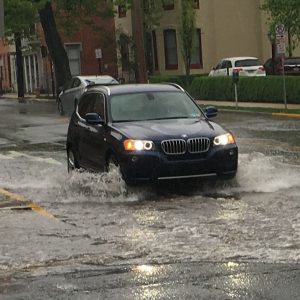We see Phase I of the Dickinson+ initiative — creation of The Alumni House @ Dickinson — as honoring the revolutionary memory of Benjamin Rush in several ways beyond the broader redefinition of liberal arts education advanced elsewhere on this site.

The Benjamin Rush Medicinal Plant Garden located at The College of Physicians Mütter Museum (19 S. 22nd St, Philadelphia). The garden is a home to more than 60 different types of medicinal and ornamental herbs. (Natalie Piserchio for WHYY)
I. THE HOME AS A USEFUL PLACE
It is traditional to think of the home as a sanctuary of sorts, a place away from where we learn and work. Benjamin Rush, the American revolutionary and visionary founder of Dickinson, had some very different — some might say revolutionary — ideas about how a home can be put to proper use.
- Home as a place to teach: Rush was a visionary regarding in-home erudition. He actively recruited medical students to lodge at his Philadelphia home so that he could more easily tutor these students in chemistry and other medical topics. Rush continued this practice even after he was married and started a family.
- Home as a place to network: It was no small side benefit that these young charges of Rush were also exposed to the many notable visitors to the Rush home during the revolutionary period, B. Franklin, J. Adams, and G. Washington being regulars among them.
- Home as a place to learn: Rush also filled his house with books, setting aside one room and stocking it with books for his wife Julia’s reading pleasure.
- Home as a place to grow: Rush advocated the use of personal and institutional medicinal gardens where one could more easily replenish one’s medical chest.
Rush’s revolutionary treatment of the home as a place for learning gives us inspiration for several revolutionary initiatives:
- An alumni-in-residence program: This program would involve short and maybe longer-term residencies where alumni could lodge, learn, and teach.
- An Alumni Library: The new alumni house might be fitted out with a proper library room, for casual browsing and more serious study. We can imagine the library being stocked with books authored or recommended, signed, and donated by Dickinson faculty and alumni. Rush’s personal bible (currently stored in the college’s archives), with notations in his own hand (see lower left page at right), might also find a new home in the Alumni House library, as well.

It is possible to add a tastefully integrate an external elevator into a historic residence. Examples are rare, though, giving Dickinson yet another opportunity to shine.
II. UNIVERSAL DESIGN
Architecture and design are in a constant state of flux as we learn more and more about how to optimize the built environment. Today, accessibility, sustainability, and the ability to flexibly adapt space for various purposes are key aspects of design that may not have been given due consideration (if they were considered at all) in the past.
The trend toward considering these aspects of architecture represents nothing short of a revolution in the design of buildings and grounds. It is that revolutionary spirit that we propose to make work done on the Historic President’s House a model of Universal Design; a showplace that not only serves as a living laboratory for our students, but as a dramatic statement about putting modern best practices about the built environment and the design of natural spaces to productive use.
III. PUBLICWORKS
Rush was also a visionary regarding public works, and his work on Dock Creek was a prime example. This shallow tributary of the Delaware River in center-city Philadelphia had become an open sewer and breeding ground for diseases that afflicted so many in his care. Rush served as the primary proponent of a project to fill in the creek and turn it into a street which became known thereafter and is known to this day as Dock St. (map).

Borough of Carlisle is another potential partner. The intersection of the High St. and West St. (pictured here, along the eastern border of the president’s house property), regularly floods when it rains. Most of the overflow comes from Dickinson properties. Renovations of the president’s house and grounds present an opportunity to work with the borough on a new and innovative storm water management system for this intersection.
Rush’s revolutionary vision of public works gives us inspiration to promote a cooperative project with the Borough of Carlisle to use the grounds of the Historic President’s House to help address the street flooding problems that regularly occur adjacent to the house at the intersection of High St. and West St. (pictured at right). The use of rain gardens and/or underground cisterns might be contemplated to manage flooding problems here.
Best management practices (BMPs) for storm water management that can be employed on this site to meet new Low Impact Development (LID) requirements include:
- Reduction of impervious pavement. There is a 12-ft. wide, 250-ft.long driveway that winds its way through the front yard of the Historic President's House property (outlined in yellow at right). Returning this 3,000 sq. ft. of pavement to permeable ground cover is the easiest and least expensive BMP to employ.
- Rainwater harvesting (RWH) systems: Underground cisterns store stormwater runoff for use in irrigation, and perhaps, even as gray water for flush toilets. Flow from building downspouts can be piped directly to the cistern to minimize the chances that water exhausted by downspouts ends up in the street.
- Rain gardens: Dickinson has a number of tastefully designed rain gardens already.
